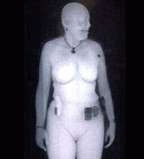The Transportation Security Administration (TSA) has installed 315 body scanners - X-ray and radio-wave booths to perform virtual strip searches - at over 65 airports throughout the United States as of December 2010. Now the TSA has not only invaded the airports with these naked body scanners, it now has plans to expand to train stations, bus terminals, and road/highway checkpoints.
Under the pretext of fighting terrorism to protect lives, the TSA exerts more harm to society by controlling the traffic flow with the installation of digital body scanners on a mass scale - causing long lines and traffic delays, imposing psychological stress on travelers, endangering human lives with unnecessary radiation exposure, violating individual privacy, and assaulting human rights with impunity.
How could the TSA with its abominable body scanners have gotten so far with such blatant violations, abuses, and assaults on ordinary citizens?
It's time to ask the RIGHT QUESTIONS.
1. What started the U.S. government's plan of mass implementation of body scanners on law-abiding citizens?
The so-called Christmas "underwear bomber" incident in 2009 is given as justification for the federal government to spend billions of dollars on the new full-body imaging devices and push them to go viral at airports.
Notice the timeline of events:
- October 2009, the TSA announced plans to expand the passenger digital strip search program.
- November 2009, the Electronic Privacy Information Center (EPIC) filed its first lawsuit against the Department of Homeland Security (DHS) for failing to present public details about its Whole Body Imaging program.
- December 10, 2009, supposedly Christmas bomber Farouk Abdulmutallab failed the attempt to blow up Flight 253.
- December 17, 2009, EPIC filed its second lawsuit against the Department of Justice in regards to the use of the body screening machines.2. How could any radiation screening be considered safe for people?
Claiming body scanners are safe, the TSA imposes airports to use the backscatter and millimeter devices to screen passengers for weapons and explosives. The backscatter machine uses x-ray radiation while the millimeter device uses radio frequency wave to create images of passengers.
Contrary to the TSA claims, four medical faculty members at the University of California, San Francisco, sent a letter to the director of the White House Office of Science and Technology Policy pointing out potentially serious health risks to children, senior citizens and pregnant women. Even two pilots unions, representing 16,000 pilots or so, told their members to avoid full-body scanning.
The backscatter devices fire ionizing radiation that penetrates a few centimeters into human flesh and reflects off the skin to produce a naked body image. The small risk associated with the low dose of radiation actually increases by the number of exposures. Why? Because X-ray radiation accumulates in the body, according to Dr. Max Gerson, a cancer specialist. Worse still, ionizing radiation used in X-ray procedures has been proven to cause gene mutation.
Citing the IAEA's 1996 Basic Safety Standards agreement that protects people from radiation, the Inter-Agency Committee on Radiation Safety concluded in their report that governments must justify the use of the body scanners. David Brenner, director of the Center for Radiological Research at Columbia University, voices his concern of unnecessary radiation exposure: "There is no good reason why [TSA] scans the head and neck, especially since you can't hide explosives there."
Moreover, CT scans ionizing radiation, similar to backscatter devises, may have contributed to 14,500 deaths and 29,000 new cancers each year, according to two studies published in Archives of Internal Medicine in 2009.
3. What is the full capability of a body scanner?
(Note: You can view every article as one long page if you sign up as an Advocate Member, or higher).





